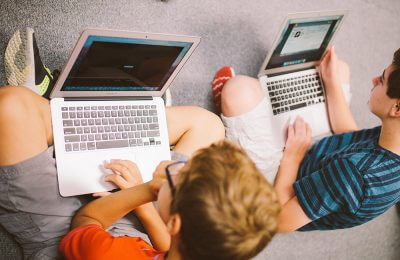May 18, 2017
 by Dr. Bill Hudson, Head of School
by Dr. Bill Hudson, Head of School
In the battle with my children over the internet, the Circle has become my favorite tool and their nemesis. If you haven’t heard of it, it is a device that connects to the home Wi-Fi and enables parents to set limits on what children are accessing online, when they can access it, and for how long. It allows us to monitor and filter what and how Mateo and Ari are using the internet. It drives the kids crazy, but gives us parents a modicum of relief in the never-ending, always contentious, struggle over screen time and technology.
The advancement of technology has made navigating childhood and adolescence increasingly complex, not only for students but for their parents as well. In particular, social media and online safety have been of particular concern. Although the research on the effects of internet use on adolescent social development is inconclusive, educators are working to better understand social interactions through technology in the larger context of adolescent development so they can help students grow into healthy and happy adults.
Kids and teens today are harnessing the immense power of digital media to explore, connect, create, and learn in ways never before imagined. With this power, young people have extraordinary opportunities, and they face potential pitfalls, too. Meanwhile, schools are dealing with the associated ramifications—like cyberbullying, digital cheating, and safety and security concerns. These issues underscore the need for students to learn digital literacy and citizenship skills.
MPA is committed to partnering with parents to navigate in this unfamiliar territory. Through parent communications and educations sessions, teachers and administrators seek to inform and empower parents to compliment and reinforce what is happening in school. Our Teachers, Technology Team, and Librarian work together to provide students with a comprehensive, safe, and ethical approach to harness the full potential of technology for learning.
Our PreK–12 technology scope and sequence covers a comprehensive list of skills and is based in part on standards from the International Society for Technology Educators. Across grade levels, skills are introduced, reintroduced, and reinforced with a goal of developing mastery. One such standard is digital citizenship. Digital citizenship refers to the norms of appropriate, responsible use of technology and an outcome of preparing students to successfully live and navigate in a world of technology. It is focused not only on what students know about technology, but how they use it.
A crucial aspect of digital citizenship is educating students about cyberbullying and internet safety. Examples of digital citizenship skills include identifying cyberbullying and describing strategies to deal with such a situation and recognizing and describing the potential risks and dangers associated with various forms of online communications. The goal is to enable students to make safe, smart, ethical decisions.
As successful as educators can be during the school day, a partnership with parents is essential. At a recent Middle School Parent Education Session, a handout was provided that offered parents 12 tips. Helpful suggestions include:
- Be aware of the age restrictions for creating social network accounts.
- Check privacy settings.
- Use filtering software.
- Create ground rules.
- Monitor screen habits of your child.
- Keep the computer in a central location.
- Avoid questionnaire, contests, and free give-aways.
- Monitor the pictures and comments your child is posting.
- Set a good example of how to use social media.
- Set limits on screen time usage.
- What goes online, stays online.
- Talk to your kids about online dangers.
A Family Media Agreement published by Common Sense Education was also distributed and can be accessed here.
In a previous message about the Netflix series “13 Reasons Why,” I shared with you that Ross and I are making our way through the series. It is disturbing on a number of levels concerning a variety of challenges young people face today. Perhaps what troubles me the most is the portrayal of parents so disconnected from their children that they are unaware of the dangers their children are experiencing and the dilemmas they are confronting. As a parent, and as an educator, I admit that there is a lot for me to learn and I am by no means perfect. The answers for parents and for educators are very simple, yet profound and difficult to achieve: be engaged, be interested, invite and model open, honest conversation and dialogue. By working together, we can provide our children with a safety net as they walk the tightrope of childhood, adolescence, and young adulthood.